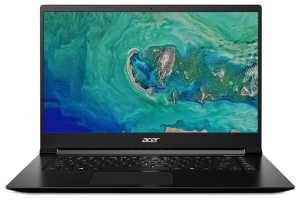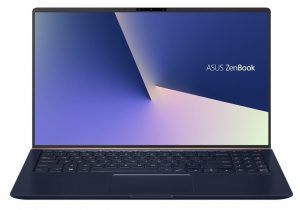AMD Radeon RX Vega M (Vega 870, 4GB HBM2) GL vs GTX 1050 Max-Q – the AMD iGPU is 18% faster than the green dedicated graphics
 The AMD Radeon RX Vega M GL is a very interesting integrated graphics. First of all, you can find it in Intel Kaby-Lake-G SoC. An Intel CPU combined with an AMD integrated graphics – it sounds a bit crazy but actually it works really well. The GL version of this AMD iGPU has its place in three Intel CPUs – Intel Core i7-8706G, Core i7-8705G, and Core i5-8305G.
The AMD Radeon RX Vega M GL is a very interesting integrated graphics. First of all, you can find it in Intel Kaby-Lake-G SoC. An Intel CPU combined with an AMD integrated graphics – it sounds a bit crazy but actually it works really well. The GL version of this AMD iGPU has its place in three Intel CPUs – Intel Core i7-8706G, Core i7-8705G, and Core i5-8305G.
This isn’t an ordinary iGPU, it has lots of power and features – it’s one of the few iGPUs with not just their own dedicated memory but with a whole bunch of it – 4GB HBM2 video buffer. This one is a beast of an integrated graphics card and in the next graphs, we will show to you why. Additionally, it takes zero space inside of the laptops because it’s part of the Intel SoC.
The GTX 1050 Max-Q is an NVIDIA GPU based on Pascal architecture. This is the least powerful GTX dedicated GPU that comes from the green team. Still, it has enough power to handle any new game. The biggest advantage of this GPU is that it can fit in slim devices compared to regular GTX / RTX GPUs because it doesn’t consume a lot of power thanks to NVIDIA’s own Max-Q tech. This is the same video card as the regular GTX 1050 but with lowered power limit and decreased frequencies. In one of our previous comparisons, we saw that the difference between GTX 1050 and its Max-Q sibling is around 15%.
Now it’s time to see where is the exact place of Vega M GL – between GTX 1050 and the Max-Q variant or it’s faster than both.
See all configurations with AMD Radeon RX Vega M / GeForce GTX 1050 Max-Q
Contents
Specs overview
The AMD Radeon RX Vega M GL is based on both Polaris and Vega (memory controller and HBM2 memory) architectures. When you look at the specs, it looks more like a dedicated video card instead of an integrated one. It has 1280 shaders, 32 ROPs, 931 MHz / 1011 MHz base and boost clocks. The efficient 4GB HBM2 memory is clocked at 1400 MHz, and its bus width is 1024-bit. The whole package (ergo CPU, GPU, and HBM2 memory) has a TDP of up to 65W. Some additional specs – Vega M GL has 80 TMUs (texture mapping unit) and 20 CUs (compute units).
The GTX 1050 Max-Q is a Pascal GPU. It’s based on the GP107 chip. The GTX 1050 Max-Q has 640 shader units, 16 ROPs, 7000MHz memory clock, 1139MHz/1328MHz base/boost frequencies, and 128-bit memory bus. The GTX 1050 Max-Q is almost the same graphics adapter as the normal GTX 1050 but it has reduced TGP and its frequencies are lower as well.
GPU comparison table
| AMD Radeon RX Vega M | GeForce GTX 1050 Max-Q | |
|---|---|---|
| Architecture | Vega | Pascal |
| GPU chip | Vega Kaby Lake-G | GP108 |
| Shader units | 1280 | 640 |
| ROPs | 32 | 16 |
| Base Clock (MHz) | 931 | 1139 (+19%) |
| Boost clock (MHz) | 1011 | 1328 (+12%) |
| Memory clock (MHz) | 1400 | 7000 |
| Memory size (MB) | 4096 | 2048-4096 |
| Memory type | HBM2 | GDDR5 |
| Memory bus width (bit) | 1024 | 128 |
| TGP (Total Graphics Power) | up to 65W TDP | 43W |
| DirectX version | 12.1 | 12.1 |
| Technology | 14nm | 14nm |
| RTX capabilities | No | No |
| Release date | 01.2018 | 01.2018 |
| Detailed specs | Link | Link |
Ok, enough paper specs, let’s see the benchmarks.
Synthetic benchmarks
A good start for AMD Radeon RX Vega M – its around 15% faster than a dedicated NVIDIA GPU – the GTX 1050 Max-Q.
Results are from the 3DMark: Fire Strike (Graphics) benchmark (higher the score, the better)
Results are from the Unigine Superposition benchmark (higher the score, the better)
| AMD Radeon RX Vega M GL over GTX 1050 Max-Q | 3Dmark Fire Strike (G) | Unigine Heaven 3.0 | Unigine Heaven 4.0 | Unigine Superposition | Average difference % |
|---|---|---|---|---|---|
| AMD Radeon RX Vega M GL | +27% | +2% | +39% | +15% | |
| NVIDIA GeForce GTX 1050 Max-Q | +1% |
Gaming tests
The Vega M GL won in the synthetics benchmarks but the real-life gaming tests are the thing that matters the most.

| Grand Theft Auto V (GTA 5) | Full HD, Normal (Check settings) | Full HD, High (Check settings) | Full HD, Very High (Check settings) |
|---|---|---|---|
| AMD Radeon RX Vega M GL | 60 fps | 53 fps | 31 fps |
| NVIDIA GeForce GTX 1050 Max-Q | 93 fps (+55%) | 55 fps | 32 fps (+3%) |
GTA V still a heavy game (especially if you crank up the advanced settings) both GPUs have similar performance here except the fact that the Vega iGPU is a lot faster at Low details.

| Far Cry 5 | Full HD, Normal (Check settings) | Full HD, High (Check settings) | Full HD, Ultra (Check settings) |
|---|---|---|---|
| AMD Radeon RX Vega M GL | 41 fps (+21%) | 37 fps (+19%) | 35 fps (+25%) |
| NVIDIA GeForce GTX 1050 Max-Q | 34 fps | 31 fps | 28 fps |
Far Cry 5 engine is still beautiful but only with the AMD video card you can enjoy 35 FPS on average (Ultra settings) while the GTX product struggles with a below 30 FPS result.

| Rise of the Tomb Raider (2016) | Full HD, Lowest (Check settings) | Full HD, Medium (Check settings) | Full HD, Very High (Check settings) |
|---|---|---|---|
| AMD Radeon RX Vega M GL | 70 fps (+29%) | 55 fps (+45%) | 27 fps (+17%) |
| NVIDIA GeForce GTX 1050 Max-Q | 57 fps | 38 fps | 23 fps |
In Rise Of The Tomb Raider, the Vega M GL is definitely faster than its NVIDIA rival no matter the details.

| Shadow of the Tomb Raider (2018) | Full HD, Lowest (Check settings) | Full HD, Medium (Check settings) | Full HD, High (Check settings) |
|---|---|---|---|
| AMD Radeon RX Vega M GL | 64 fps (+36%) | 37 fps (+37%) | 34 fps (+3%) |
| NVIDIA GeForce GTX 1050 Max-Q | 47 fps | 27 fps | 33 fps |
Shadow Of The Tomb Raider is the newest installment of the Lara Croft adventures. If you like this series of games the AMD iGPU is the way to go here if you plan to play on Medium. At High Preset both video cards are close.

| Tom Clancy’s Ghost Recon Wildlands | Full HD, Medium (Check settings) | Full HD, High (Check settings) | Full HD, Very High (Check settings) |
|---|---|---|---|
| AMD Radeon RX Vega M GL | 40 fps (+18%) | 37 fps (+19%) | 33 fps (+22%) |
| NVIDIA GeForce GTX 1050 Max-Q | 34 fps | 31 fps | 27 fps |
Wildlands is a heavy open-world game and the integrated AMD iGPU is always faster here, even at High preset.
Performance summary (gaming tests)
Believe it or not, an integrated iGPU that is part of Intel SoC just beat a mid-range NVIDIA GPU – GTX 1050 Max-Q.
| AMD Radeon RX Vega M GL over GTX 1050 Max-Q | Full HD, Low | Full HD, Normal | Full HD, High | Average difference % |
|---|---|---|---|---|
| AMD Radeon RX Vega M GL | +10% | +30% | +13% | +18% |
| NVIDIA GeForce GTX 1050 Max-Q |
Verdict
We are a bit surprised but in a good way. The AMD Radeon RX Vega M GL is 18% faster on average than NVIDIA GeForce GTX 1050 Max-Q and by our calculations, it’s on par with the non-MAX GTX 1050. Not bad at all. This collaboration between the two giants (Intel and AMD) is a really strong one. It’s a powerful combo that is faster than any other CPU + iGPU combination (except the other sibling – Vega M GH). On top of that, even the GTX 1050 Max-Q is slower than Vega M GL. The advantages of the latter include better power consumption, lower heat dissipation, low total weight, better battery life, better portability, and faster performance. That’s because the iGPU doesn’t take extra space inside of the laptop and it’s not heating up that much the internals during heavy loads.
The GTX 1050 Max-Q is still a decent dedicated graphics from NVIDIA. The only problem for it is that in this comparison it’s not performing that good when it’s compared to the Vega M GL. The laptops that come with this NVIDIA GPU are heavier, thicker, and more power-hungry (at least most of them) than the ones that are configured with Kaby Lake G SoCs.
At the end of the day, one of the most important things when buying a new laptop is its price. The RX VEGA M GL is 18% faster than GTX 1050 Max-Q and it’s completely fine to prefer a Kaby Lake G device if it’s around 20% more expensive than a GTX 1050 Max-Q laptop. If the price is higher – the choice is yours, you already know the pros and cons of both GPUs.
All laptops equipped with the AMD Radeon RX Vega M GL
All laptops equipped with the NVIDIA GeForce GTX 1050 Max-Q














